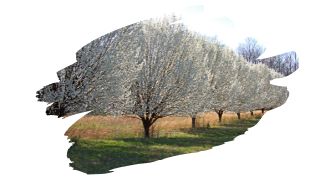Do you want to keep your home warm? Looking for affordable firewood?
Well, the Bradford Pear tree is certainly an abundant source of wood in a lot of US states. In fact, this fast growing deciduous tree can be found right across America, and can grow to over 18m (60ft) in height.
So, what’s stopping you from using Bradford Pear tree wood in your fireplace?
Well, in this post, you’ll learn what actually makes for good firewood — and what kinds of timber should not make it into your fireplace. You will also discover why Bradford Pear tree firewood is better for a fireplace than even traditional Oak or Birch wood.

This post may contain affiliate links to products that we receive a commission for (at no additional cost to you). Learn more here.
What’s The Best Type Of Firewood For An Indoor Fireplace?
The safest type of firewood needs to fit three key criteria; firewood needs to be dry, needs to contain little sap, and firewood mustn’t come from a poisonous tree species.
Once those three criteria are met, you can then begin to look at things such as how much heat certain types of wood produce. Now, as a general rule of thumb, dense hard timbers produce more heat than low density woods.
So, with these things in mind, two of the most reliable sources of firewood fuel are White Oak and Birch wood.
These two dense hardwoods meet all of the key criteria for firewood…and some. What’s more, they are affordable, and grow abundantly across North America and Europe.
Related Post: Is A Willow Tree A Good Source For Firewood?
What About Smoke? How Do You Keep Smoke Emissions To A Minimum?
When firewood produces a lot of smoke, it is usually because of moisture. Moisture inside firewood vaporises, turning into steam when that log is burned. And that extra steam makes smoke much thicker, (and lung clogging), than usual.
So, if you can minimize the moisture in firewood, (before you burn it), you’ll minimize the amount of smoke.
Now, the simplest way to dry out firewood is to season it. And seasoning wood simply involves leaving freshly cut firewood to dry for around 6 to 12 months.
This process should be enough to greatly reduce the moisture content found inside freshly logged lumber by over 80%. And you can learn more about how to speed up the process of seasoning by checking out our post: Season Wood.
Related Post: Is Hackberry Tree Wood Good For Firewood?
And What Is Moisture Content Exactly?
Moisture content is how we measure the amount of water in a piece of wood. Freshly cut wood, (called green wood), has a moisture content around 100%.
However, after seasoning, woods moisture content will have reduced to less than 20%. And, in some extreme cases, you can get that moisture content level to as low as 12% through seasoning.
What Kind Of Wood Should Not Be Burned In A Fireplace?
Any wood that comes from a poisonous or otherwise toxic tree species has no place in your fireplace. That’s because the poisonous compounds in these trees, can collect in soot, smoke and fumes.
Also, you should avoid burning firewood with a lot of sap or pitch in it. These sticky tree resins can also collect in soot as well.
However, the risk from tree sap/pitch lies in these tree resins causing chimney flue blockages. When a chimney flue becomes blocked, then chimney fires can occur.
Related Post: Is Apple Wood Good Enough For Firewood?
Okay…So What Does This All Mean For Using Bradford Pear Tree Wood As Firewood?
Well, the Bradford Pear tree produces very dense tough timber. And this tree is not toxic.
What’s more, it is not saturated with tree resins. Plus, this tree grows incredibly quickly and abundantly.
So, all in all, the Bradford Pear tree makes for really good firewood.
In fact, it could be argued that the Bradford Pear tree is even better than White Oak or Birch. And why is that? Well, it all boils down to the amount of heat that this lumber can produce.
The BTU (British Thermal Unit) of a piece of wood measures how much energy it takes for fire to consume wood.
The higher the BTU, the more energy it takes. And the more energy it takes, the more heat is produced in your fireplace.
Now, the Bradford Pear trees lumber has a 26.5 BTU rating. Compared to Birch’s 23.6 BTU rating, and White Oaks 25.7 BTU, the Bradford Pear tree has them both beat.
In short, Bradford Pear tree wood is a fantastic choice for heating your home.
To Wrap Up, Here Are The 3 Key Takeaways From This Post…
- 1). The best type of firewood needs to be dry, contain very little sap, and it needs to be fairly dense.
- 2). Which is why White Oak and Birch wood often top the list as two great choices for firewood.
- 3). However, Bradford Pear tree firewood is even better than Oak or Birch wood. That’s because this tree produces more heat as it burns (compared to Oak or Birch).
References:
Wood Smoke Awareness | EPA.gov



